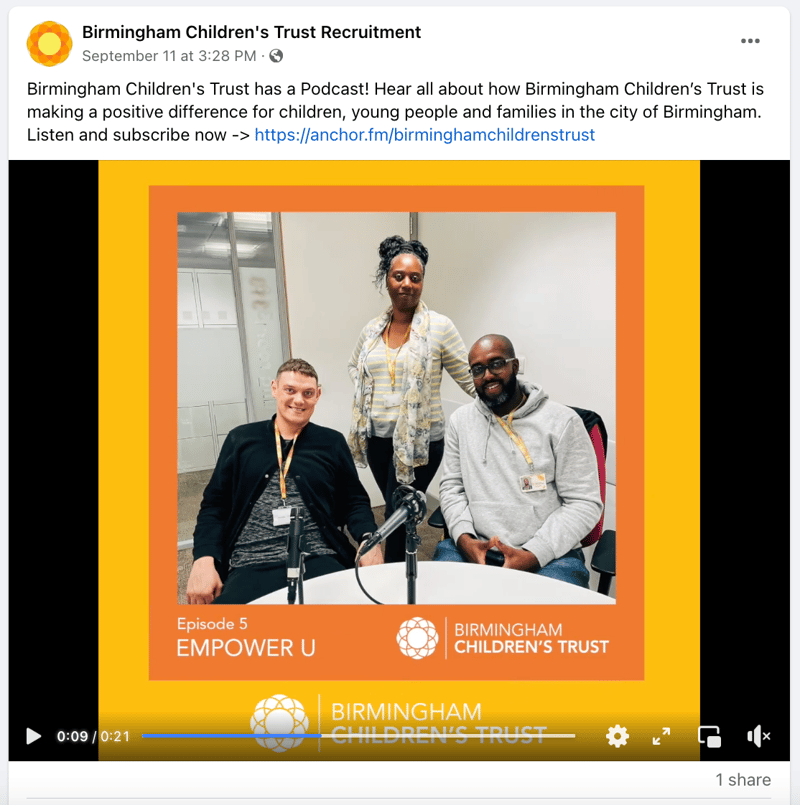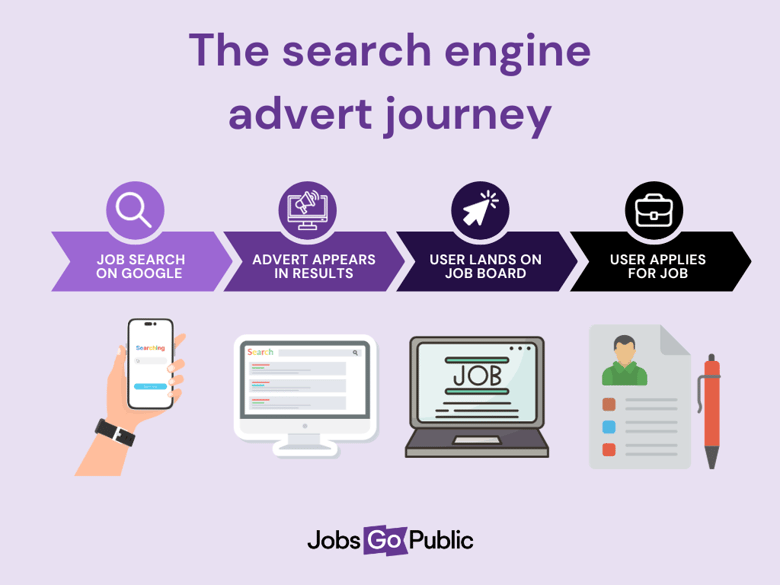Beyond traditional methods: recruitment marketing for local government
Are you up to date with current recruitment marketing methods, or falling behind the competition?
In the internet age it’s easier than ever to advertise your roles – yet the recruitment marketplace has also never been so noisy.
Bustling your way to the top of the pack of employers to reach relevant talent is a daunting task. Even more so when limited public sector budgets make it crucial to make the right hire first time.
That’s why we’ve put together this introduction to four methods of recruitment marketing you need to make part of your hiring strategy.
Table of contents
1. The traditional approach to recruitment
2. Why up your recruitment marketing game?
3. Four methods to include in your talent strategy:
The traditional approach to recruitment
The tried and tested method for attracting jobseekers in the 21st century is an advert placed through an online job board.
Since the 1990s, when job boards such as our very own jobsgopublic.com began to appear, this method has forged the way for digital recruitment.
This is still a popular form of job advertising, with half of public sector organisations currently advertising roles on generalist job boards.
However, this is a very passive approach to finding candidates. Hoping candidates will simply come to you is no longer enough to bring in skilled hires.
Jobseekers have access to mountains of vacancies and employer information at the touch of a button. We’re often asked to help our clients stand out from the crowd - and our advice is always to adopt a proactive approach to talent acquisition.
Why up your recruitment marketing game?
A solid recruitment marketing strategy is an investment which extends your reach to jobseekers who might not otherwise find you.
A multi-channel approach ensures you can:
- Engage candidates at multiple touch points in their job hunt
- Promote what makes your organisation a better place to work
- Reach passive jobseekers who aren’t actively browsing job sites
- Show off your people, your social value and your workplace (if applicable)
- Attract a more diverse pool of talent.
.png?width=788&height=443&name=recruitment%20marketing%20mindmap%20(1).png)
Candidates who engage with your outreach are more likely to be enthusiastic about your shared values, making them an excellent fit for your work culture.
This ultimately leads to more successful onboarding, higher levels of retention, and reduced reliance on agency staff to keep crucial services running.
Four methods to include in your talent strategy
1. Social media
Currently less than half of public sector employers use social media as a recruitment tool.
Promoting your workplace organically on social media is a simple way to build your employer brand. This method is low-hanging fruit, being free and easy to access.
What’s more, candidates from all generations of jobseekers visit employers’ social media before applying for jobs. Startups Magazine state that two thirds of millennials and just under half of baby boomers assess employer brand with this method.
In an extremely competitive job market you can’t afford to be missing out on these well-informed jobseekers.
But what are some of the ways we can use social media to entice candidates to apply for our jobs?
One of the key advantages that platforms like LinkedIn, Facebook and X (formerly Twitter) have over job boards is mixed media formats.
Videos are an extremely powerful tool for engaging with your audience.
On average, people view 17 hours of videos online weekly. What’s more, users retain 85% more information from videos than from reading text.
Use social media to showcase information about your culture:
- Your team’s success stories
- Behind-the-scenes content about a day in the life of an employee
- Links for your vacancy postings
- Activities that show off your organisation’s values in practice.
Social media is an underutilised platform in the public sector recruitment space. But it’s a fantastic opportunity to show the human side of your workforce, as well as prove you walk the walk when it comes to the promises made in your job adverts!
For an excellent example of social media recruitment marketing in practice, check out the Birmingham Children’s Trust Facebook page. They offer a great mix of resources, from videos by their Heads of Service to podcast episodes!

2. Performance marketing
2.1 Search engines
In a recent survey of our jobseeker audience, 72% of respondents said they use search engines like Google to start their job search.
However, only 12% of UK employers are using paid advertising such as Google Ads to reach candidates!
This means that hiring managers who are making use of this platform are getting their ads seen well before anyone else.
So how does it work?
This form of advertising comes under the umbrella of performance marketing, where the advertiser only pays for results.
In simple terms, your adverts are shown to users who are searching on Google with phrases related to your campaign. Every time a user clicks on your advert, you pay a small fee to the search engine.
Search engine marketing is a fantastic way to reach jobseekers at the very start of their job application journey.
A performance marketing specialist can help you by writing engaging advert copy, selecting the right keywords to bid on, and targeting highly relevant candidates with your jobs. In turn, you can maximise the amount of high-quality traffic that lands on your job advert within your budget.

This platform is especially effective because it combines human marketing expertise with artificial intelligence (AI). When used, search engine AI predicts the outcome of a user seeing your ad, and only shows it when users are most likely to click.
Allowing your ads to run consistently collects anonymous data about your recruitment campaign. This data on user behaviour makes these predictions even more accurate over time.
Combined with consistent optimisation by a performance marketing specialist, you can achieve maximum ROI (return on investment), even with a constrained budget.
2.2 Programmatic advertising
We can’t mention performance marketing without a nod to programmatic job advertising. This is a form of job board advertising that uses AI to increase the reach of your job adverts.
In essence, software intelligently handles the placing of your job posts based on the rules you set for your campaign. Programmatic software makes targeting candidates effortless by allowing the software’s AI to decide on the right platforms with the most relevant jobseekers.
Jobs Go Public enhances our clients’ recruitment marketing campaigns by working with a programmatic software partner called Appcast.
Appcast revolutionised the programmatic game by allowing their partners to pay a small fee per application.
Through this platform we were able to boost Halton Borough Council’s campaign applications by over 12 times. To find out more about how we transformed their social care recruitment by combining performance marketing with candidate management, read our case study.
3. University job fairs
If you’re looking for a method to solve problems with workforce planning, you need to be at job fairs.
Feedback we often hear from our clients is that many experienced employees are heading towards retirement age, creating a succession challenge. One of the methods used to combat this in recent years has been to target over 65s to come back into the workforce part time.
During the cost of living crisis, this may provide a stopgap. However, this is not a sustainable long-term solution for growing skills shortages.
Another way you can bridge this gap is to grow your talent from within.
An OECD survey of global workforces demonstrates that a universal reason people love working for the public sector is a cultural focus on learning and development.
Tapping into the graduate audience at careers fairs provides a perfect opportunity to grab jobseekers at the start of their careers, so that you can train and promote experienced staff internally.
Local government is not yet a career path many young people consider. This is largely due to misconceptions about what councils do.
Attending fairs at your local university allows you to make an instant impact and speak directly to candidates who could become part of your organisation.
Benefits of job fairs:
- Face to face interactions with jobseekers that raise awareness of your employer brand among a large group of candidates in a short space of time.
- An opportunity to assess potential applicants’ suitability for your roles on the spot.
- The ability to build an instant talent pool of active jobseekers who can be contacted for future opportunities that fit their skills profile.
- Exposure to a diverse range of candidates, including those who may not have previously considered a public sector career or those who may struggle with complex written applications.
- An opportunity for staff in your organisation to share real world stories about why they love working for you.
The private sector often has a strong presence at these fairs, using them to network with university leavers.
Don’t miss out on competing with these employers by selling the opportunity to make a difference!
4. Career sites
Our last method is your one-stop shop for all things employer brand: a career site.
So why do career sites matter?
Around two thirds of Jobs Go Public candidates look for a dedicated careers page when weighing up an organisation’s employer brand.
These pages are an easy source of information about your values, work culture, and benefits packages. It’s likely when you ask an interview candidate why they applied for your role that they have tried to find a page like this in their preparation stage.
These jobseekers want to see transparency and assurance that your organisation’s culture aligns with their career aspirations. It’s an opportunity to go beyond your job adverts and prove you can walk the walk, as well as talk the talk!
Imagine you are a disabled candidate and you read in a job advert that an employer is “inclusive”. You research the company but you can’t find any information about their ED&I policy or reasonable adjustments.
How can you trust that the employer really cares about making the workplace accessible for you?
A career site is the platform where you can provide the proof to back up your claims.
Looking for some inspiration for your employer brand? Check out our blog on fantastic examples of how public sector employers promote their brand through career sites.
How can we help?
From social media to the power of search engine advertising, these methods can help you to level up your recruitment efforts.
Embracing a multi-channel recruitment strategy that engages candidates all the way from the start of their job search to the interview stage is the best way to get ahead of your competition.
With the right recruitment marketing approach you can improve onboarding, boost retention rates and reduce your dependence on agency staff.
If you’re inspired to transform your talent strategy but don’t know where to start, let us help!
Updated 12 July 2024